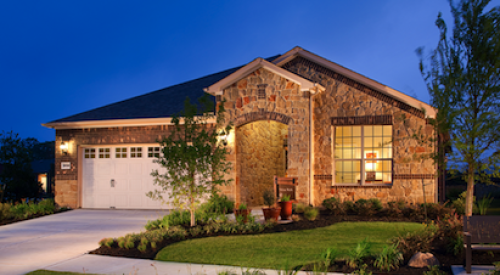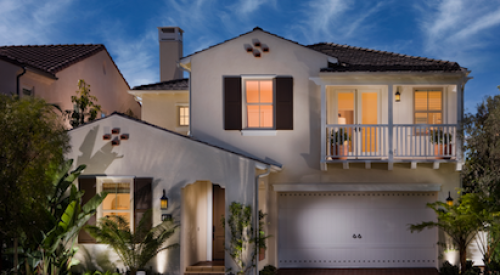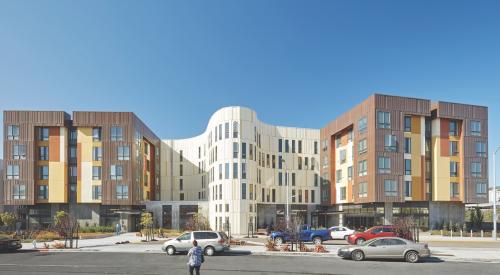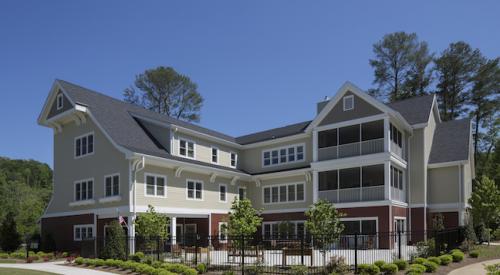| Carolina Trace already has 1100 homes, two mature golf courses, and has been selected by Reader’s Digest as one of America’s top 20 retirement destinations three years in a row.
|
Forget everything you know about the active adult market. It’s probably all wrong, now that the baby boom generation is charging into that market segment. From 40 years of past experience, we know one thing about the boomers: whatever their parents did, they’re likely to do something entirely different. Instead of golf, they may be more interested in white water rafting.
Long-time golf community marketing pro and home builder Larry Torrence has studied aging boomers closely for the last three years. Due to a stroke of bad fortune, he learned even more about the new members of the active adult market. In 1998, just as Torrence was about to close on the last 33 acres of land at the 2500-acre master-planned community of Carolina Trace (in Sanford, N.C.), the owner suddenly died, throwing the parcel into probate court. But that dark cloud had a silver lining.
"The estate resolution cost us a year and a half," Torrence says, "but it gave us more time to devote to planning. We could have built the usual golf villa and done just fine...
"But during the delay, I kept taking phone calls from prospects. They would talk at length about what they were looking for, and I began to see that a typical ‘retirement community’ just doesn’t cut it for this new generation."
Torrence began to see why the baby boomers baffle and fascinate consumer product marketers: there are a whole lot of them, and they are maddeningly unpredictable. He had a sudden inspiration: Could his Cottage Village project, 100 detached homes on a 33-acre site in one of America’s top retirement destinations, be valuable to corporate America as a test market? A microcosm of aging boomers to study and probe for responses to new products?
| Builder Larry Torrence says decks won’t work in his TND design, but "Big, deep porches in front and back will."
|
Torrence tested his idea by contacting major corporations through their web sites. "Some thought I was nuts, but enough thought I was on to something to form Cottage Village Corporate Partners," he says.
The fledgling program now has 16 members, among them General Electric, Kohler, Carolina Power & Light and Pella. Torrence approached them offering a test market and seeking expertise, not money.
He had already decided that his village would be a modified Traditional Neighborhood Development. No alleys, but with historic Carolina architecture featuring metal roofs and wide, wrap-around porches.
"I talked to so many who said they want to live in a real community, where they know their neighbors as friends, not just acquaintances," says Torrence. "I really believe the TND concept strikes a chord with boomers."
Robert Orr, a New Haven, Conn.-based architect, played a key role in the progress of Torrence’s corporate partners program. First, his name alone gave Torrence credibility in corporate America. Orr also worked the research ideas and new products of the corporate partners into his designs without treating them, as many architects might, as an unwelcome intrusion.
"It didn’t compromise our design," Orr says. "Quite the contrary. They had a lot of good information to share with us from their research into these buyers."
So what will the product be? You’ll have to wait a while to see furnished models. Construction will start soon. But Torrence already has nine pre-sales on the books. And we know how the village will be laid out, and what the home exteriors will look like. Buyers are choosing from just three floor plans, three exterior color choices, and the footprints of the houses are cast in stone. The plans range from a two-bedroom of 1590 square feet that starts at $197,500 to a 2100 square-foot four-bedroom starting at $257,500.
One interesting design feature is that all the houses provide space for a huge home office. "Boomers will not stop working when they retire," says Torrence.
Beyond that, buyers have many product selection choices. That’s where the test market concept comes into play. A design coordinator will take buyers through the detailing process, with alternative products displayed in a 4000 square-foot design center.
The corporate partners also contributed mightily to solving some sticky design problems. For example, while those wide, wrap-around porches help make the place pedestrian-friendly and sociable, they also make the interiors dark. The corporate partners’ research showed that’s not what aging boomers want.
Enter Pella, with suggestions and products to bring more light into those challenging interiors. They were also able to accommodate changes to counter heights suggested by kitchen and bath designer Mary Jo Peterson, whose services were donated by General Electric.
"We vary counter heights from as low as 30 to as high as 42 inches. That variety works, and also creates visual interest in the room. We also vary both the height and depth of cabinets, so they look and work better."
Research also presented Orr with a dilemma over dining rooms. Half of boomers still want a formal dining space, the rest think it unnecessary. Enter Carolina Power & Light with the idea of a "dining room" defined by walls of light. "They have a line of halogen lights that are trapped," explains Peterson, "so the light doesn’t escape beyond the line that defines the ‘wall.’ It really does create a sense of formal dining."
Torrence may not have all the answers for appealing to aging boomers, but he seems to have a head start on his competitors. "This is really a terrific concept," says Connecticut-based market researcher Myril Axelrod. "Carolina Trace is doing better than anyone else at recognizing how baby boomers will change the active adult market. These are coddled consumers, who are used to being the center of attention. We’d better have the right product for them when they reach retirement because they expect it."












